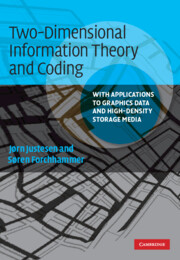 Two-Dimensional Information Theory and Coding
Two-Dimensional Information Theory and Coding Published online by Cambridge University Press: 05 June 2012
Introduction
This chapter describes fields of discrete symbols over finite alphabets A (with ∣A∣ symbols). Such fields can serve as models of graphics media or of other forms of two-dimensional (2-D) storage medium. By addressing the storage medium as a surface on which an image array may be written, the density may be increased. Besides optical storage, new storage techniques based on holography and nano-technology have been demonstrated. Two-dimensional barcodes have also been designed for coding small messages, but increasing the capacity compared with conventional barcodes, which carry information in one dimension only. The Datamatrix is an example of such a code. We focus on 2-D constrained coding for storage applications, but the models presented are more general and they may be used for other applications as well.
Two-dimensional fields with a finite constraint
The symbols are placed in a regular grid (commonly referred to as a lattice) and indexed a(i, j), where i, j are integers. The first index indicates rows and the symbols are spaced at equal intervals within the row. We usually consider rectangular grids on which the symbols are aligned in columns indicated by the second index. However, the symbols in row i + 1 can be shifted a fraction of a symbol interval relative to row i. In particular, a shift of half a symbol interval gives a hexagonal grid. The mutual dependency of symbols is often described in terms of neighbors.
To save this book to your Kindle, first ensure [email protected] is added to your Approved Personal Document E-mail List under your Personal Document Settings on the Manage Your Content and Devices page of your Amazon account. Then enter the ‘name’ part of your Kindle email address below. Find out more about saving to your Kindle.
Note you can select to save to either the @free.kindle.com or @kindle.com variations. ‘@free.kindle.com’ emails are free but can only be saved to your device when it is connected to wi-fi. ‘@kindle.com’ emails can be delivered even when you are not connected to wi-fi, but note that service fees apply.
Find out more about the Kindle Personal Document Service.
To save content items to your account, please confirm that you agree to abide by our usage policies. If this is the first time you use this feature, you will be asked to authorise Cambridge Core to connect with your account. Find out more about saving content to Dropbox.
To save content items to your account, please confirm that you agree to abide by our usage policies. If this is the first time you use this feature, you will be asked to authorise Cambridge Core to connect with your account. Find out more about saving content to Google Drive.